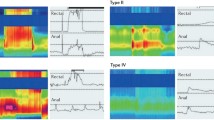Opinion statement
The diagnosis of slow transit functional constipation is based upon diagnostic testing of patients with idiopathic constipation who responded poorly to conservative measures such as fiber supplements, fluids, and stimulant laxatives [1••]. These tests include barium enema or colonoscopy, colonic transit of radio-opaque markers, anorectal manometry, and expulsion of a water-filled balloon [2•]. Plain abdominal films can identify megacolon, which can be further characterized by barium or gastrografin studies. Colonic transit of radio-opaque markers identifies patients with slow transit with stasis of markers in the proximal colon. However, anorectal function should be characterized to exclude outlet dysfunction, which may coexist with colonic inertia [3]. Because slow colonic transit is defined by studies during which patients consume a high-fiber diet, fiber supplements are generally not effective, nor are osmotic laxatives that consist of unabsorbed sugars. Stimulant laxatives are considered first-line therapy, although studies often show a diminished colonic motor response to such agents. There is no evidence to suggest that chronic use of such laxatives is harmful if they are used two to three times per week [2•]. Polyethylene glycol with or without electrolytes may be useful in a minority of patients [4], often combined with misoprostol [5,6]. I prefer to start with misoprostol 200 mg every other morning and increase to tolerance or efficacy. I see no advantage in prescribing misoprostol on a TID or QID basis or even daily because it increases cramping unnecessarily. This drug is not acceptable in young women who wish to become pregnant. An alternative may be colchicine, which is reported to be effective when given as 0.6 mg TID [7]. Long-term efficacy has not been studied. Finally, biofeedback is a risk-free approach that has been reported as effective in approximately 60% of patients with slow transit constipation in the absence of outlet dysfunction [8,9]. Although difficult to understand conceptually, it is worth attempting and certainly so in patients with associated pelvic floor dyssynergia. Subtotal colectomy with ileorectal anastomosis is often effective in those patients with colonic inertia, normal anorectal function, and lack of evidence of generalized intestinal dysmotility [10•]. However, morbidity is significant both early and late in the disease process and must be balanced against current disability [11–13]. Ileostomy is preferred in the presence of anorectal dysfunction or with associated impairment of continence mechanisms. Similar considerations apply to the patient with disabling functional megacolon. An alternative approach is ileostomy with disconnection of the colon, which is more acceptable to some patients who may hope for future reconnection if recovery occurs. An additional alternative approach for patients with colonic inertia or megacolon who are not good surgical risks is tube cecostomy (or in children, use of the appendix as a conduit to the cecum). This permits either decompression (in megacolon) or antegrade enemas (in colonic inertia). Our surgeons are not enthusiastic about this approach, and I have little experience with it. In general, the use of partial resections of the colon should be discouraged, because marker studies do not define pathophysiology in patients with slow transit constipation.
Similar content being viewed by others
References and Recommended Reading
Locke GR, Pemberton JH, Phillips SF: American Gastroenterological Association: technical review on constipation. Gastroenterology 2000, 119:1766–1778. A comprehensive literature review and recommendation prepared for the American Gastroenterological Association and endorsed in principle by the other gastroenterologic societies.
Wald A: Constipation. Med Clin North Am 2000, 84:1231–1246. A recent review of the evaluation and management of chronic constipation
Wald A: Outlet dysfunction constipation. Curr Treat Options Gastroenterol 2001, 4:293–297.
Corrazziari E, Badiali D, Bazzochi G, et al.: Long-term efficacy, safety and tolerability of low daily doses of isosmotic polyethylene glycol balanced solution in treatment of functional chronic constipation. Gut 2000, 46:522–526.
Soffer EE, Metcalf AM, Larenspach J: Misoprostol is effective treatment for patients with severe chronic constipation. Dig Dis Sci 1994, 39:929–933.
Roarty TP, Weber F, Soykan I, McCallum RW: Misoprostol in the treatment of chronic refractory constipation: results of a long-term open trial. Aliment Pharmacol Ther 1997, 11:1059–1066.
Verne GN, Eaker EY, Davis RH, Sninsky CA: Colchicine is an effective treatment for patients with chronic constipation: an open-label trial. Dig Dis Sci 1997, 42:1959–1963.
Koutsomanis D, Lennard-Jones JE, Kamm MA: Prospective study of biofeedback treatment for patients with slow and normal transit constipation. Eur J Gastroenterol Hepatol 1994, 6:131–137.
Chiotakakou-Faliakou E, Kamm MA, Roy AJ, et al.: Biofeedback provides long-term benefit for patients with intractable slow and normal transit constipation. Gut 1998, 42:517–521.
Wofford SA, Verne GN: Approach to patients with refractory constipation. Curr Gastroenterol Rep 2000, 2:389–394. A concise and well-written review of management recommendations for constipation that is refractory to standard treatments.
Platell C, Scache D, Momme G, Stitz R: A long term follow-up of patients undergoing colectomy for chronic idiopathic constipation. Aust N Z J Surg 1996, 66:525–529.
Pluta H, Bowes KL, Jewell LD: Long-term effect of total abdominal colectomy for chronic idiopathic constipation. Dis Colon Rectum 1996, 39:160–166.
Knowles CH, Scott M, Lumiss PJ: Outcome of colectomy for slow transit constipation. Ann Surg 1999, 230:627–638.
Bleijenberg G, Kuijpers HC: Biofeedback treatment for constipation: a comparison of two methods. Am J Gastroenterol 1994, 89:1021–1026.
Author information
Authors and Affiliations
Rights and permissions
About this article
Cite this article
Wald, A. Slow transit constipation. Curr Treat Options Gastro 5, 279–283 (2002). https://doi.org/10.1007/s11938-002-0050-x
Issue Date:
DOI: https://doi.org/10.1007/s11938-002-0050-x




